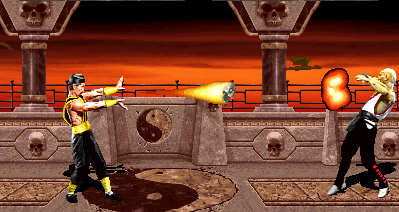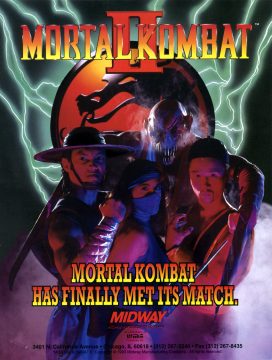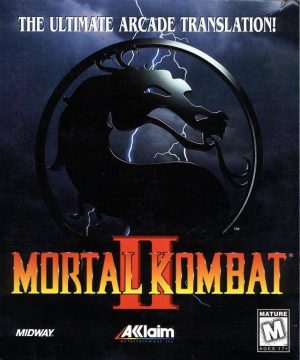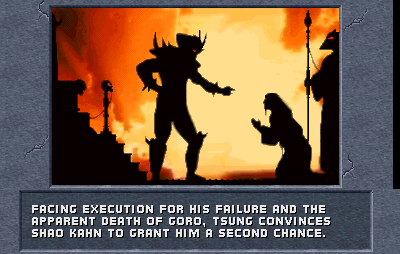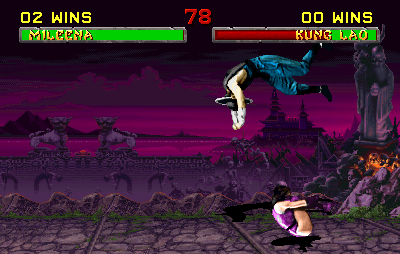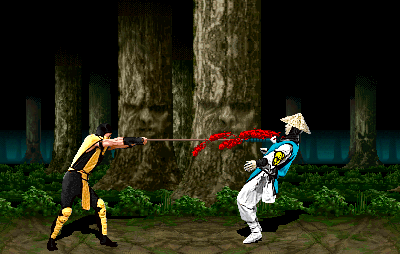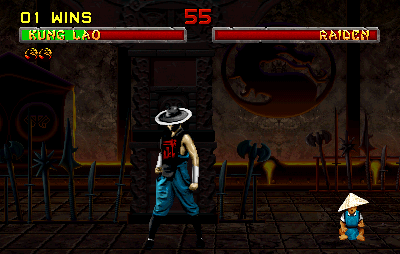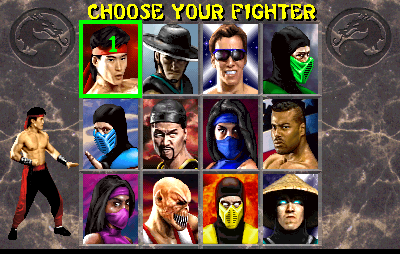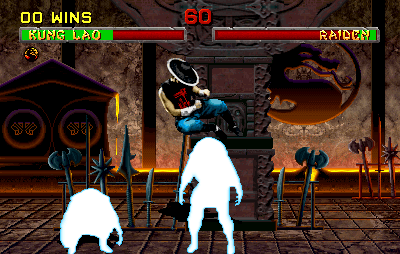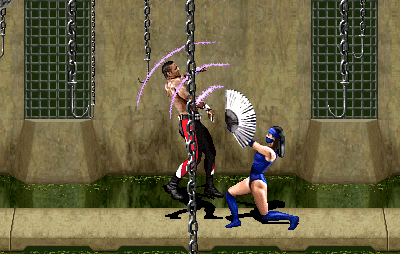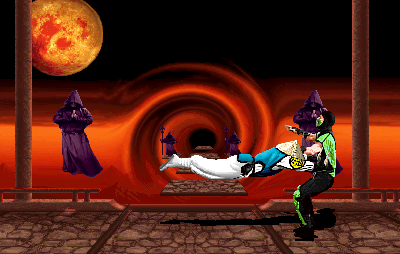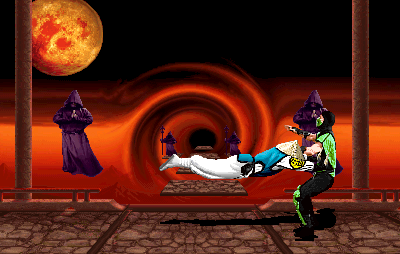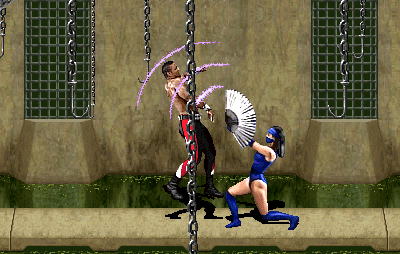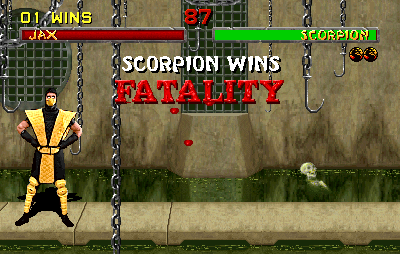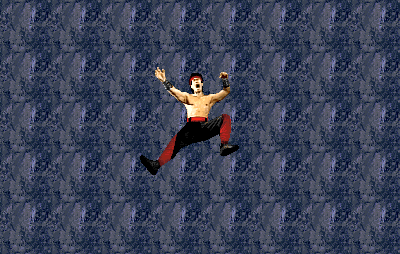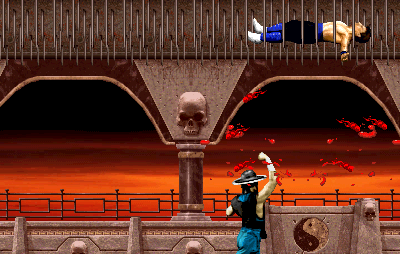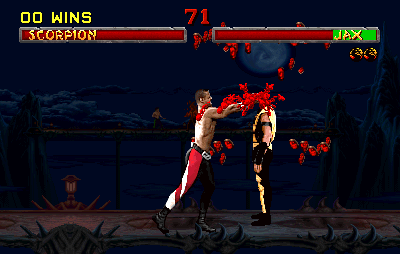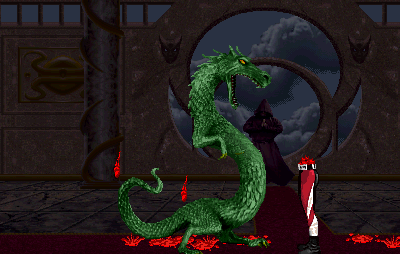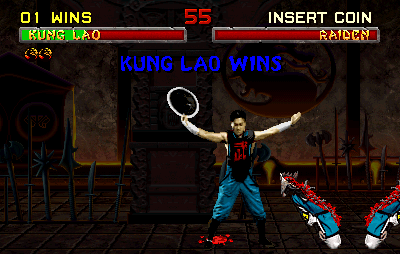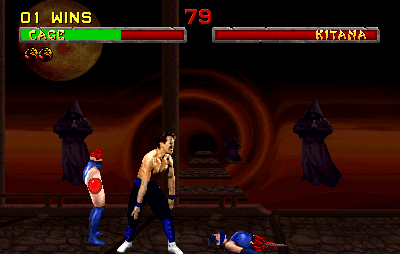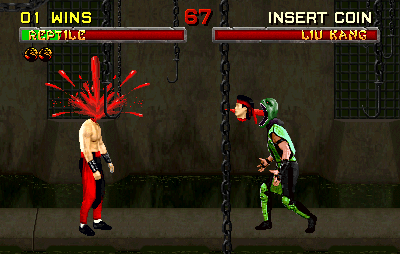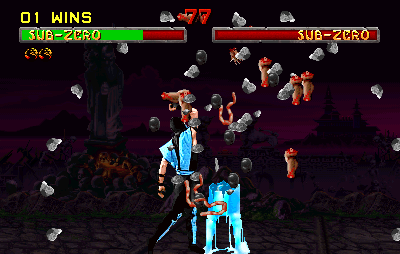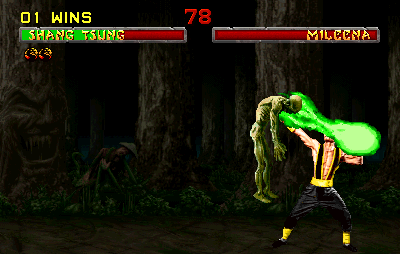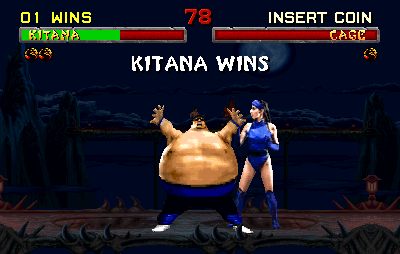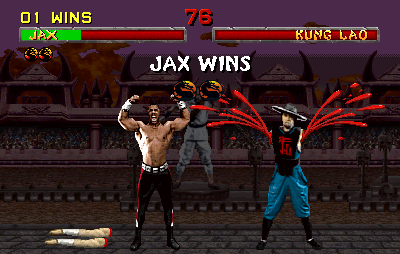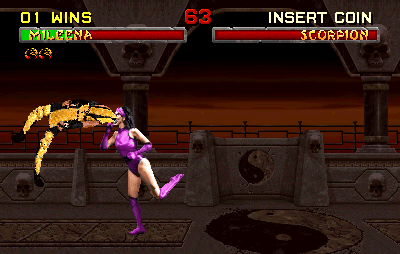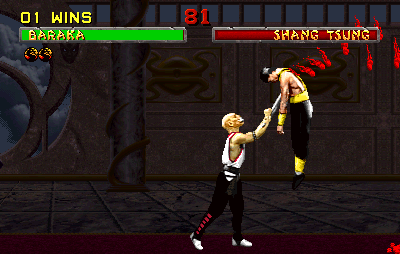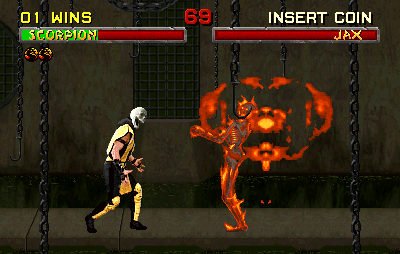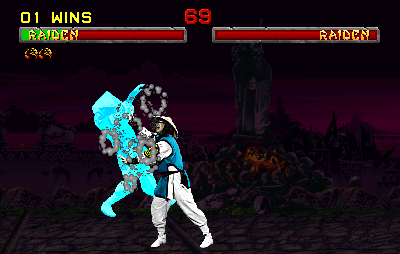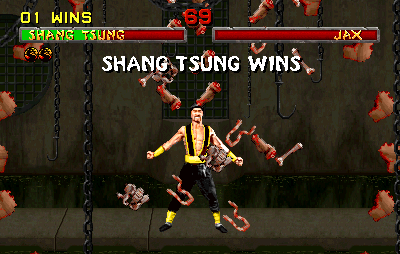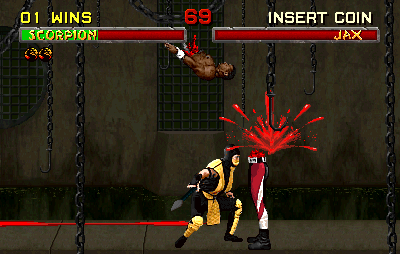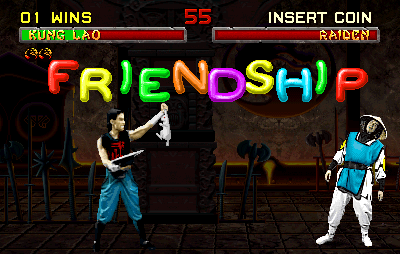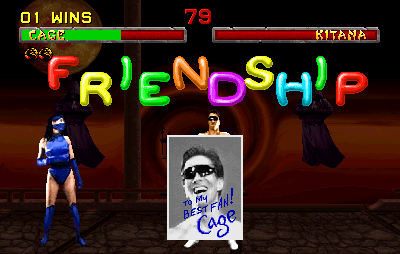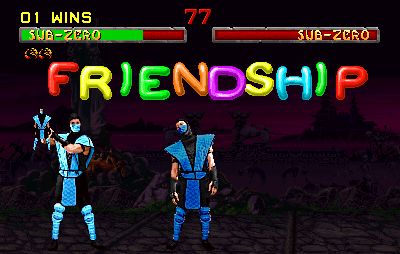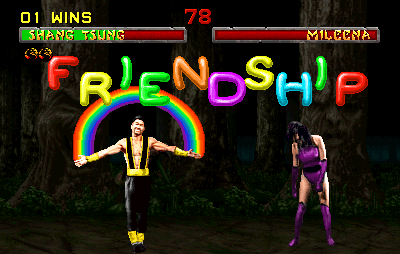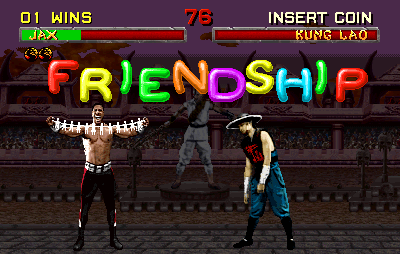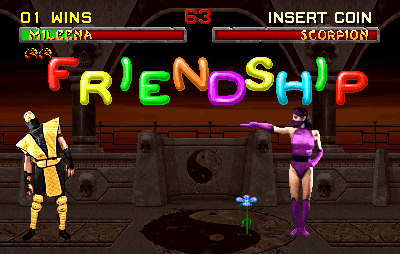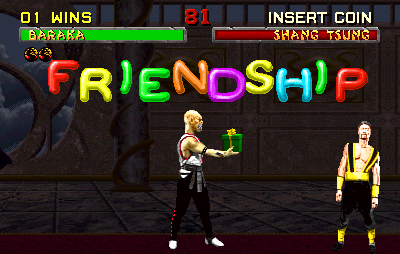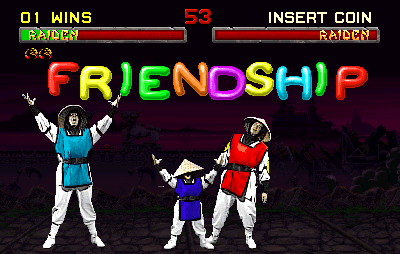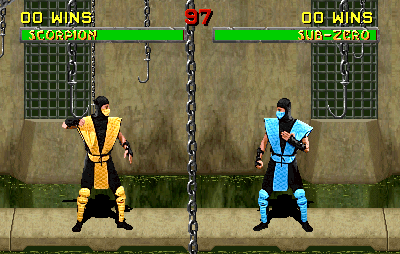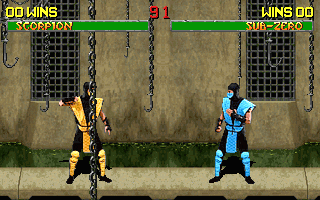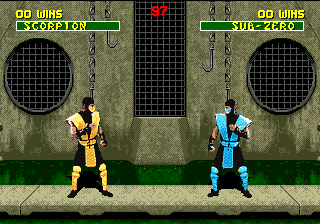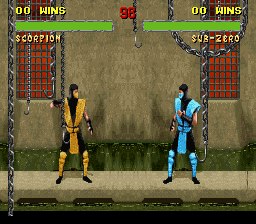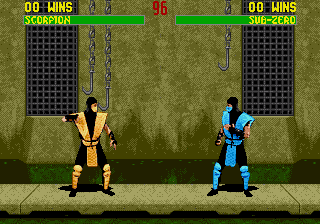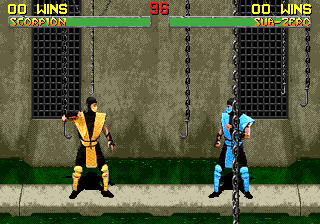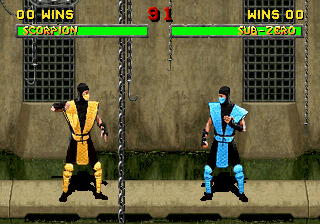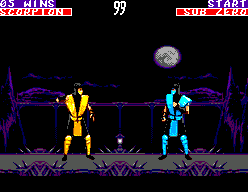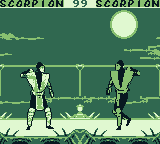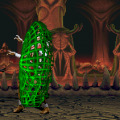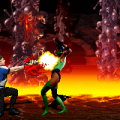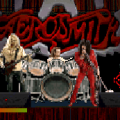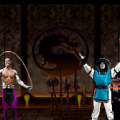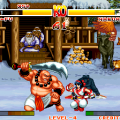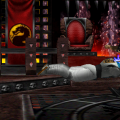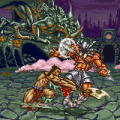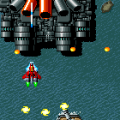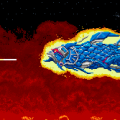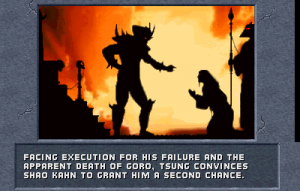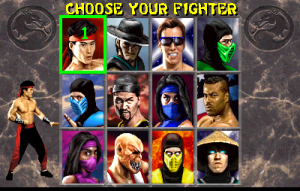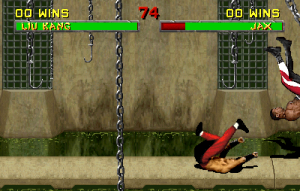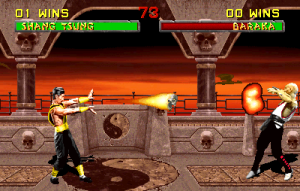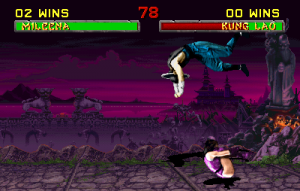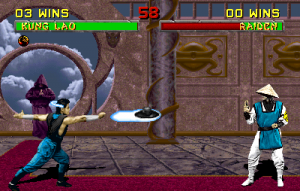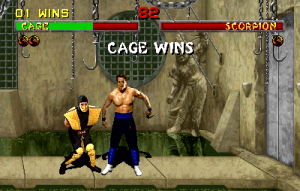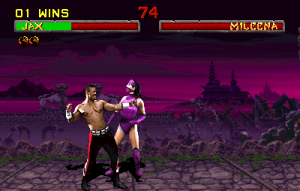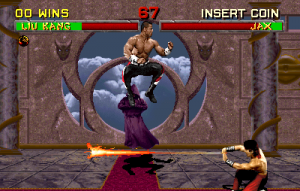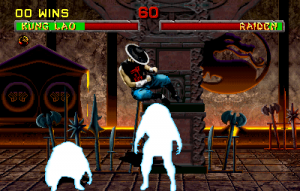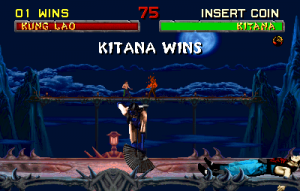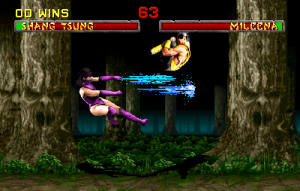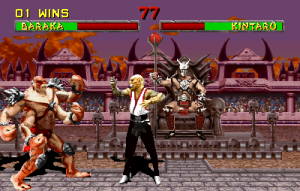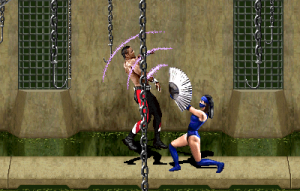- Mortal Kombat (Introduction)
- Mortal Kombat (1992)
- Mortal Kombat II
- Mortal Kombat 3
- Ultimate Mortal Kombat 3
- Mortal Kombat Trilogy
- Mortal Kombat 4
- Mortal Kombat Mythologies: Sub-Zero
- Mortal Kombat: Special Forces
- Mortal Kombat: Deadly Alliance
- Mortal Kombat Deception
- Mortal Kombat: Shaolin Monks
- Mortal Kombat Armageddon
- Mortal Kombat VS DC Universe
- Mortal Kombat (2011)
- Mortal Kombat X
- Mortal Kombat (Miscellaneous)
Thanks to Liu Kang’s victory over Shang Tsung at the end of the original Mortal Kombat, Earthrealm was saved from invasion at the hands of the evil Shao Kahn. The ruler of Outworld is not very happy about this, until Shang Tsung has a new plan for him. If Shao Kahn can host a tournament in Outworld, the Earthrealm fighters will be forced to fight at a disadvantage. While he’s at it, he sends an army to destroy Liu Kang’s monastery. Kano and Sonya also end up getting captured, adding even more motivation for the heroes of Earthrealm to get back into the fight. Most of the characters from the original MK return, with Shang Tsung and Reptile making their first playable appearances. Shang Tsung still has his morphing ability from the original game, which lets him morph into any of the playable characters whenever he wants. If you can memorize the inputs, this can open up an insane amount of strategic potential.
The controls are unchanged, although some of the characters have some new close-range strikes. Some of these can pop your opponent into the air, letting you get some extra hits in if you’re good with your juggle combos. Everybody has more special moves now, with most characters getting three or four each. It doesn’t sound like a lot, but it certainly opens up a lot more options than the previous game. If you know when and where to use your special moves, you can create some impressive juggle combos, some of the first seen in any fighting game of the time. Unlike Super Street Fighter II, however, the game won’t count for you how many hits you have in your combo.
The single player mode is improved in some ways, with some downgrades in other areas. The good news is that the Endurance Matches are gone entirely, so you’ll never be put into a situation where you’re expected to beat two fighters on one life bar. The problem is that hardly matters because the AI is cranked up to such an insane level that it’ll most likely take you hours to get to where the Endurance matches were in the first place. At first, the difficulty isn’t too bad. Once you get about three or four matches in, however, the AI cranks up to such high levels it becomes an absolute struggle to finish each match. The computer learns to counter everything you try, and eventually it starts to actively cheat to defeat you, like slowly inching forward under a series of projectiles while crouched. Enemies also love to throw you, especially if you try to throw them, in which case the AI wins every time.
Once you get to the bosses, things get even tougher. Kintaro is more or less Goro 2.0, able to teleport at will and fire projectiles that take off a major chunk of your health. Shao Kahn, however, is on a level of SNK boss hell reserved only for the likes of Rugal and Gill. He does a ton of damage with every hit, takes much less damage than anybody else, and can counter your attacks more or less any time he wants by kicking you to the other side of the screen. During all this, the booming voice of Steve Richie constantly taunts you, saying things like “Is that your best?” and “You will never win!”. He’s got such an awesome voice that it takes a lot longer than you’d think to get annoying, although it can get discouraging very quickly. If you manage to beat him, he gives off one big, dramatic “No…. no… noooooo!” before turning to stone and exploding into pieces for no real reason besides that it looks really cool.
Of course, with as big of a draw as the Fatalities were, they had to bring them back, and now everybody gets two of them. Some of these are pretty brutal, like Jax tearing off somebody’s arms, or Shang Tsung turning into Kintaro and punching the opponent in half. Some are just kind of weird, like Kitana’s kiss, which causes the enemy to expand like a balloon and explode. Liu Kang also kept his lame “fatality” from the first game, where he does a forward flip and uppercuts the opponent, leaving them intact. However, he did get an awesome second Fatality where he turns into a dragon and bites the opponent in half, which makes up for that. There’s more ways to finish off your opponent with the environment, although this time you can’t simply perform them with a single uppercut. Instead, every character has their own specific inputs for performing a stage Fatality. You can knock your opponents into pools of acid, lift them flying into a ceiling of spikes, or send them plummeting into a pit full of… concrete. That’s a bit of a step down, you have to admit.
This time around, however, with all the controversy the original Mortal Kombat stirred, there’s a couple of new ‘finishers’ that aren’t quite so deadly. There are the ‘Friendship’ moves, where, instead of killing off your opponent, you do something ‘friendly,’ like growing a flower, doing a disco dance, or giving them a present. These are about as stupid as they sound, although they make a great way to humiliate a human opponent. What’s really funny, though, is Shao Kahn’s confused reaction to the whole thing. “Liu Kang wins! Friendship! …Friendship?” Besides the Friendships, there’s also Babalities, where you… turn your opponent into a tiny, diaper-clad version of themselves. …Huh!
The inclusion of the hidden challenger Reptile had people scouring MK2 for its secrets, and there were plenty to find. This time around, there are three secret challengers, each with their own unique conditions for fighting them. None of them are quite as obscure as what you had to do to meet Reptile, although have fun playing 50 VS matches in a row to encounter Noob Saibot. Much like Reptile, these hidden bosses are simple pallete swaps of the playable characters, given buffs to make them more challenging. Jade is a female ninja in green, who has a total immunity to projectiles. Noob Saibot and Smoke borrow Scorpion’s moves and costume, although they’re much faster and powerful than the yellow ninja. Much like Reptile before them, these pallete swaps would eventually get their own identity and moves. If you happen to have entirely too much time and/or money on hand, playing 250 two-player matches in a row will unlock a round of Pong, which is great, considering how likely you are to be sick of MK after that many matches. There’s also a small easter egg where some guy’s head pops out of the corner of the screen and sing out “Toasty!” This is actually Dan Forden, the sound designer for the MK series, and his cameo appearances have always been an iconic, if a little silly, part of the series.
The hardware’s been upgraded since the original game, so the character sprites are larger, and the backgrounds get more detail. There’s even more blood this time around, with whole bucketloads spilling out on particularly powerful hits. So much so, that even the letters for ‘FATALITY’ bleed when somebody pulls one off. The new backgrounds are also nice, with one of the more iconic stages being the Dead Pool. It’s a small concrete room, where your fighters stand on a very treacherous concrete platform, surrounded by acid. Hooks and chains dangle from the ceiling, implying all sorts of nasty things that would go on here. The sound and music are also much better this time around, as well. The music hardware has been upgraded from the old Yamaha chip to Midway’s DCS Sound System. While the music still has the same Oriental sound to it as the original game, the actual quality of the instrumentation makes it sound nearly CD quality.
Overall, Mortal Kombat 2 is the game most people think of when they remember Mortal Kombat, and there’s a lot of good reasons for that. It’s generally a more polished product, with much higher production values. The gameplay’s also been vastly improved, with all the new moves and characters, and it’s generally a lot more fun to play than the original game. It might not be up to the best of the many versions of Street Fighter II, but it’s still an enjoyable game. Unfortunately, some of the complaints some people might have of the original game, like the lack of character uniqueness or the control layout, haven’t been fixed. Still, if you enjoyed the first game, you’ll probably end up loving this one.
Compared to Nintendo’s poor showing the first time around, their ports for MK2 are much, much better. After the release of the original Mortal Kombat, Nintendo got slammed for the censorship of the game. And so, after sticking a label to the box of the SNES version that warned it was for Mature Audiences only, Mortal Kombat would finally see an unedited release to Nintendo consoles. It also plays much better, with the controls being much more responsive than the SNES port of the original game. While the graphics and sound can’t quite match up with the arcade, the tradeoff is that there’s a secret “team battle” mode. In this mode, two players pick four characters and fight it out, with a new character appearing whenever one loses all their health, sort of like King of Fighters. Interestingly enough, while the Western versions of this port are uncensored, the Japanese version has green blood. The screen also fades to black and white whenever a Fatality’s performed, although the actual Fatalities themselves are unchanged. But you still can’t pause the game. Sorry.
The Game Boy version plays worlds beyond the Game Boy port of the original MK, so much so that it’s probably one of the best fighters on the handheld. The speed of the game has been cranked up massively since the original, so it’s no longer too choppy to control. The controls have also been made more responsive, so it’s quite possible to pull off your special moves. Blocking’s been moved to the Start button, which frees up the face buttons for pulling off your moves. While there’s no blood in the actual game, a few of the Fatalities from the arcade version have made the tranisition, as opposed to the original port’s sanitized “finishing moves.” The downside is that they’ve removed four of the playable characters, and out of the remaining eight, three are male ninjas, and two are female ninjas. That leaves only three characters who aren’t recolors of each other, on a system that doesn’t actually have any color. This means picking out which ninja is yours isn’t always easy, except by going by their stance, name, and which particular shade of grey they are.
The Genesis version plays great, and while it doesn’t look or sound as good as the SNES version, there’s more speech and more detail than the Genesis port of the original game. It also has support for the Sega Activator, if you’ve just stepped out of a time machine from 1993 and actually own one. The always fantastic Matt Furniss composed the music for this port as well, giving his own spin on the soundtrack. Whether it’s superior to the arcade’s soundtrack is again a matter of opinion, though. Just like the SNES version, this port’s also uncensored by default. You still can’t pause, though. The 32X version is an enhanced version of the Genesis port, with bigger sprites, more frames of animation, and most of the speech that was cut from the Genesis version. It also reuses the soundtrack from the Genesis version, which makes a great bonus if you enjoy that particular soundtrack. If you have a 32X, this is the version you want, as it’s probably the most arcade-perfect experience you can get except for playing the game through emulation.
The Game Gear and Master System versions are mostly identical, aside from the latter having a bigger screen. They’re both mostly based off of the Game Boy version, with the same roster, controls, and Fatalities. Since the Game Gear is in color, it’s a bit easier to distinguish the different ninjas. The Game Gear version also seems to be a little more polished than the Game Boy version, with the dripping ‘Fatality’ text and a sound clip of Shao Kahn saying ‘Fight!’ the Game Boy version also doesn’t have. On the other hand, it feels like it doesn’t play quite as smoothly as the Game Boy version, although you could do much, much worse if you’re looking for fighters on the Game Gear. The Master System version, is once again the only one that lets you pause the game, with blocking being done by hitting the punch and kick buttons together.
The Saturn version is one of the better ports, and the only CD version of MK2 you’re likely to come across. It looks nearly exactly like the arcade version, and it has a smoother framerate than most of the other versions. The only real flaw is that there’s some very short loading times any time Shang Tsung morphs. They’re only about a second long, but if you play as Shang Tsung a lot, you’re liable to notice. The music’s also been redone from the arcade version for whatever reason, and it sounds a lot worse. There’s also a lot of voice clips and sound effects missing, which can make the game sound quieter than it should be. Still, it’s a good choice if you happen to have a Saturn, even if there are better 2D fighters on the console.
The DOS version, just like MK1, is one of the best of the early ports. It looks almost arcade perfect, and the joystick controls have been improved if you don’t want to use a keyboard. The music still isn’t great, but it’s worth tracking down if you want a decent MK port. Unfortunately, no matter what version you get, you’re stuck with the music being played through your sound card. It doesn’t sound awful, but it doesn’t sound as good as the arcade version’s music.
The Amiga version is a slight step up from the port of the original game, although not by much. There’s now support for two button joysticks, although that doesn’t make pulling off any of the moves any easier. The graphics look a little nicer than the original game, as well, you still have the limited color pallete and cut frames that come standard with ports of these sort of games to Amiga hardware. You still have to deal with the loading times and disk swapping, however, and since there’s much more data to load then there was in the first game, it’s even more frequent.
The PlayStation version, oddly enough, was only released in Japan a full three years after the original arcade release. At first glance, it looks, sounds, and plays fairly faithfully. The biggest problem, however, is that this port has to load from the disc for just about everything, even just when characters are performing special moves. There are so many pauses that actually playing through a match is a major excerise in frustration, especially in any match where Shang Tsung gets involved. This port’s best left avoided in favor of the cartridge or Saturn versions, especially for the extra hassle of actually finding it.
Much like the first game, the Arcade Kollection port is pretty much arcade perfect, aside from a few sound issues. It still has the same online issues, though.
Fatalities
Friendships
Comparison Screenshots
